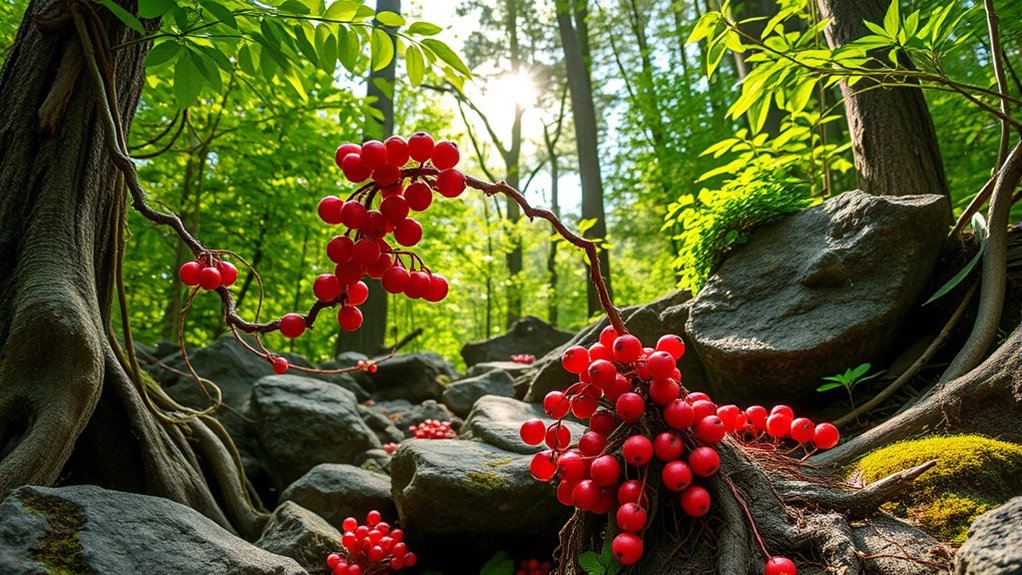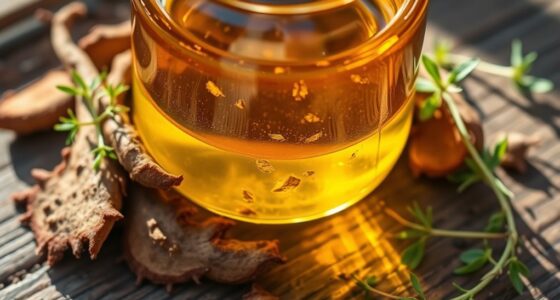To harvest Rhodiola and Schisandra in the wild, first learn their natural habitats—mountain rocky terrains for Rhodiola and moist forests for Schisandra—and recognize their key features. Use sharp tools during peak seasons—late spring for Rhodiola roots and late summer for Schisandra berries—while practicing sustainable techniques that protect plants. Properly store and handle your harvest, ensuring quality and longevity. Continue exploring to discover more about ethical harvesting and incorporating these adaptogens into your wellness practices.
Key Takeaways
- Identify Rhodiola and Schisandra by their habitat, physical traits, and growth stages for effective wild harvesting.
- Harvest Rhodiola in late spring to early summer and Schisandra in late summer to early fall for peak potency.
- Use sustainable tools and methods, such as selective trimming, to minimize environmental impact and support plant recovery.
- Store wild-harvested adaptogens in airtight, dark containers to preserve their medicinal qualities and longevity.
- Follow local regulations and practice ethical wildcrafting to protect plant populations and ensure ecological balance.
Recognizing Rhodiola and Schisandra in Their Natural Habitats
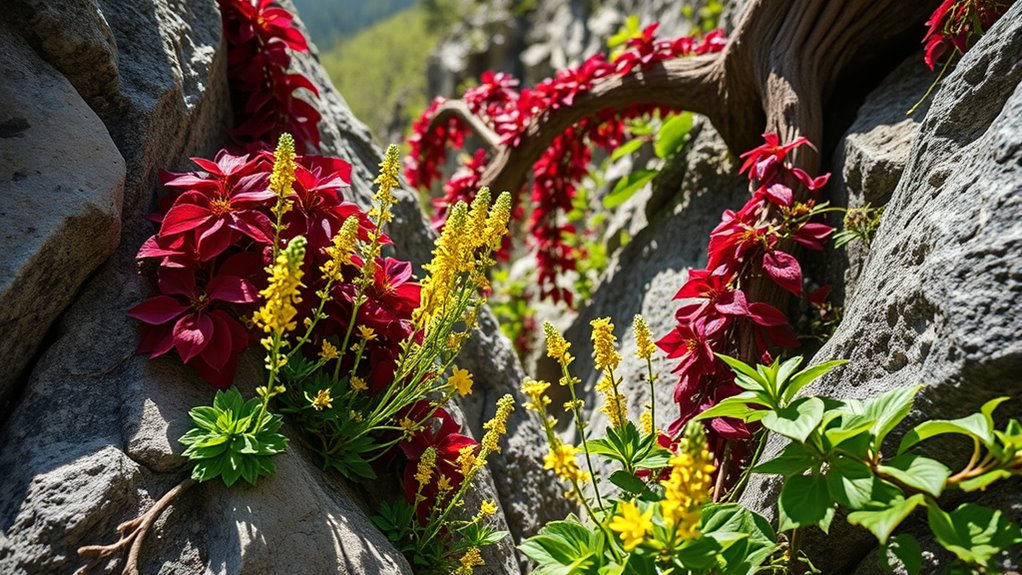
To identify Rhodiola and Schisandra in their natural habitats, you’ll want to observe their distinctive features and growing conditions. Rhodiola typically thrives in cold, mountainous regions with rocky, well-drained soils. Its botanical characteristics include low-growing, perennial herbs with bright yellow or orange roots and small, greenish leaves. In contrast, Schisandra prefers forested areas or shaded woodlands with moist, fertile soil. It’s a woody vine with woody stems and clusters of bright red berries, which are a key botanical characteristic. The plant’s leaves are oval and glossy, and its twining stems help it climb onto trees or shrubs. Recognizing these habitat preferences and botanical traits is essential for correctly identifying these adaptogens in the wild. Additionally, understanding the plant habitat can greatly improve your chances of successful identification and harvesting.
Best Seasons and Timing for Wild Harvesting
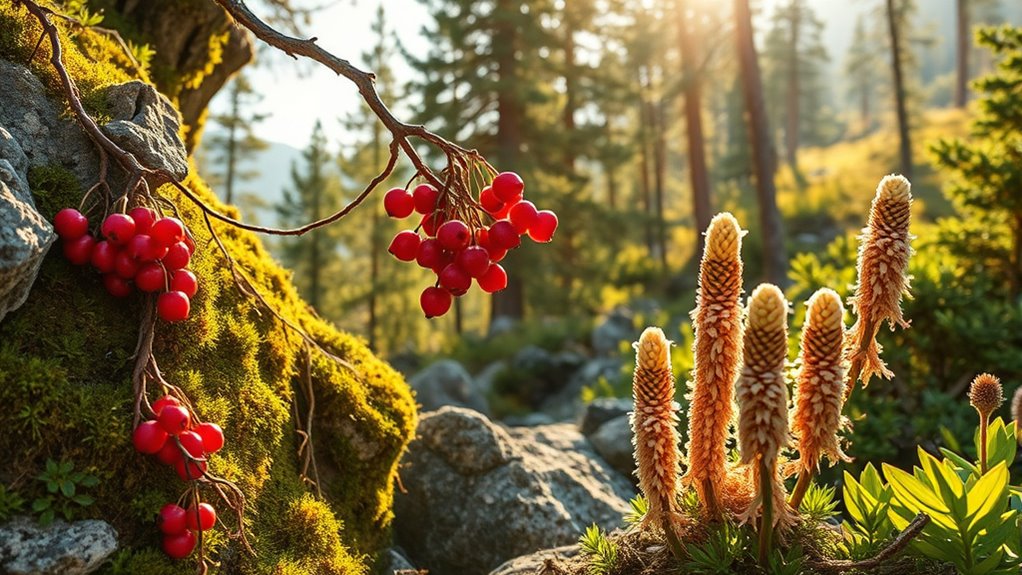
To harvest adaptogens at their best, you need to guarantee attention to the right seasons and timing. Picking plants during their peak potency ensures you get the most effective benefits. Keep an eye on environmental factors like weather and plant maturity to make your harvest truly successful. Additionally, understanding plant growth cycles can help you identify the optimal moments for harvesting wild adaptogens.
Optimal Harvest Seasons
Choosing the right time to harvest adaptogens in the wild is crucial for guaranteeing their potency and health. The key is to align your harvest with their seasonal growth cycle, when plants reach peak plant maturity. For Rhodiola, late spring to early summer is ideal, as its roots develop full flavor and medicinal compounds during this period. Schisandra berries are best harvested in late summer to early fall when they’re fully ripe and their phytochemicals peak. Harvesting too early means the plant hasn’t accumulated enough active compounds, while waiting too long can result in a decline in potency. By paying attention to seasonal growth patterns and plant maturity, you guarantee your harvest delivers maximum adaptogenic benefits.
Timing for Peak Potency
Timing your wild harvest for peak adaptogen potency depends on understanding the specific growth cycles of each plant. For Rhodiola, the best time for peak harvesting is late spring to early summer, when the plant’s roots reach full maturation and contain the highest concentration of active compounds. Schisandra berries are at their most potent when ripe, typically in late summer to early fall, just as their seeds turn bright red. Harvesting too early means the plants haven’t fully matured, reducing the adaptogenic qualities. Conversely, waiting too long can lead to diminished potency or overripe fruits. Knowing the plant’s maturation stage ensures you collect at the ideal time for maximum peak harvesting, preserving the highest levels of beneficial compounds. Additionally, understanding the plant’s growth cycle can help identify the optimal harvesting window for sustained potency over multiple seasons.
Environmental Factors to Watch
Environmental factors play a essential role in determining the best seasons and timing for wild harvesting adaptogens. Climate variations influence plant growth cycles, so timing your harvest when plants are at their peak is critical. Soil conditions also matter: healthy, well-drained soil promotes stronger, more potent plants. To maximize your harvest, consider these key factors:
- Climate variations: Harvest during stable weather periods, typically late summer or early fall.
- Plant maturity: Wait until plants reach full maturity, usually indicated by flowering or fruiting stages.
- Soil conditions: Ensure soil is rich, well-drained, and minimally disturbed for prime plant health.
- Optimal growth conditions: Monitoring environmental factors such as temperature and humidity can help determine the best harvest timing, as these influence plant potency and overall quality.
Monitoring these factors helps guarantee you’re harvesting at the right time for maximum adaptogen potency.
Tools and Techniques for Ethical and Sustainable Collection
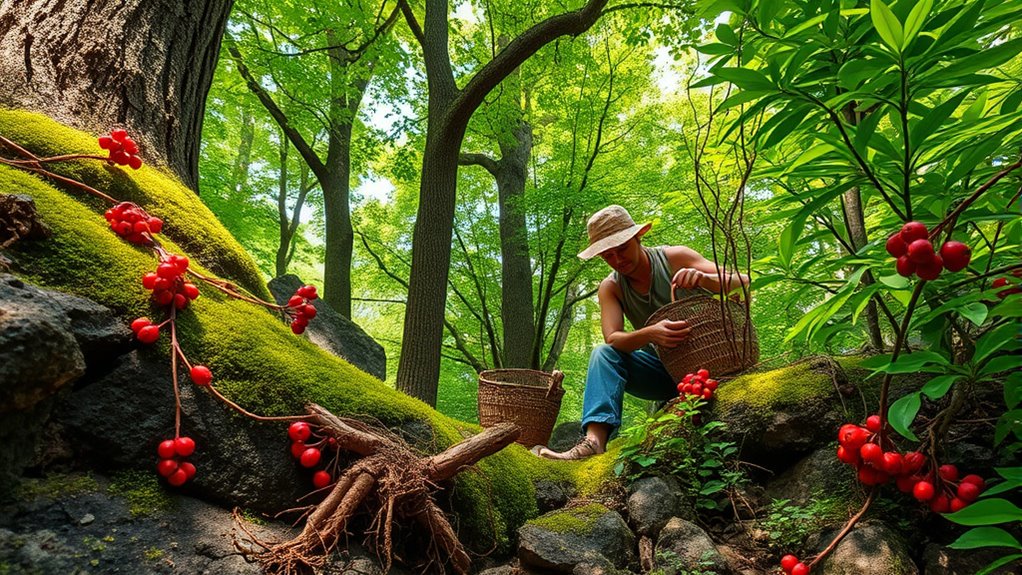
To guarantee ethical and sustainable collection of adaptogens, you need to employ tools and techniques that minimize environmental impact and respect local ecosystems. Start with sharp, lightweight tools like pruning shears or small knives to reduce plant damage. Use sustainable foraging practices by harvesting only what you need and avoiding overharvesting, ensuring the plants can regenerate. Avoid damaging roots or removing entire plants; instead, trim selectively to promote future growth. Wear gloves to protect both you and the plants, and mark your collection sites to prevent repeated disturbance. Always follow local guidelines and regulations, respecting the land and community. These measures help ascertain your harvesting supports the health of wild populations while allowing future foraging opportunities. Research suggests these practices can also support plant resilience and long-term sustainability.
Identifying Quality Plants and Avoiding Look-Alikes

Accurately identifying high-quality adaptogens is essential to guarantee you harvest potent and safe plants, but many species have look-alikes that can be easily mistaken. Proper plant identification ensures you target the right species without risking toxicity or environmental harm. To distinguish quality plants, focus on:
- Physical characteristics: Note leaf shape, stem structure, and root appearance.
- Habitat: Recognize preferred growing conditions and geographic locations.
- Timing: Harvest at the right season when active compounds peak.
Proper Handling, Storage, and Preparation of Harvested Plants
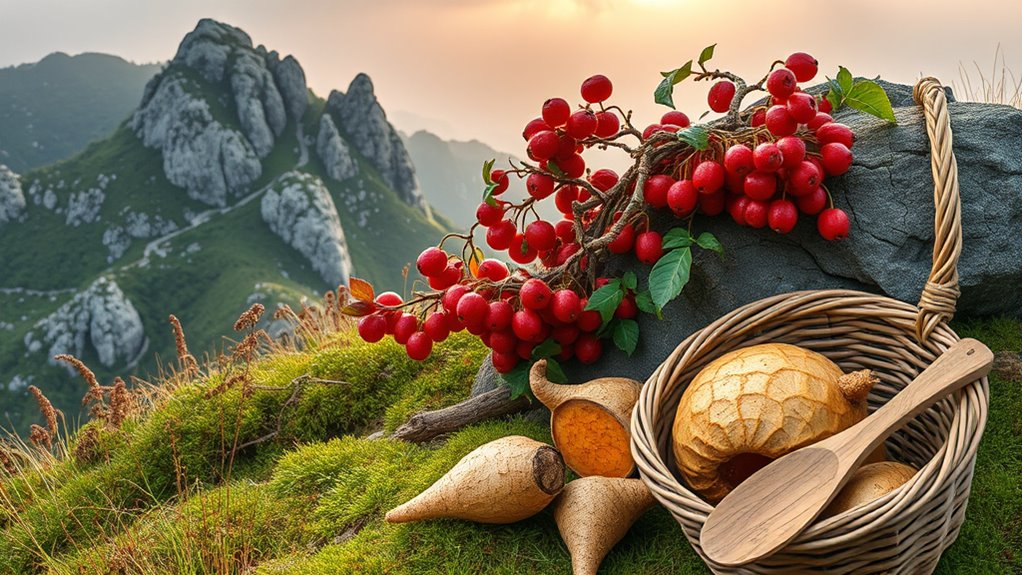
Once you’ve harvested your adaptogens, proper handling and storage are vital to maintain their potency. You’ll want to choose effective drying and preservation methods to prevent mold and decay, and store the plants in a cool, dark place. When preparing them for use, follow specific tips to maximize their health benefits and ensure safety. To further protect your harvest, consider regulatory compliance guidelines to ensure safe and lawful handling of medicinal plants.
Drying and Preservation Methods
Proper drying and preservation are essential steps to maintain the potency and quality of adaptogens after harvest. First, you should choose a suitable method like sun drying, which uses natural heat and airflow to dry plants gently. Be sure to spread the herbs evenly in a single layer, turning occasionally to prevent mold. Second, once dried, store your herbs in airtight containers to keep out moisture and preserve their active compounds. Proper storage prevents degradation caused by light, air, and humidity. Third, keep the containers in a cool, dark place to extend shelf life. This approach ensures your adaptogens stay potent and effective, ready for use when needed. Proper handling during drying and storage is key to maintaining the herb’s medicinal qualities.
Storage and Preparation Tips
After harvesting your adaptogens, handling them with care is essential to preserve their potency. Proper storage and preparation maintain their traditional uses and cultural significance. Store dried roots and berries in airtight containers, away from light, heat, and moisture. Label everything clearly to avoid confusion. When preparing, gently clean the plants to remove dirt without damaging delicate structures. Consider drying herbs further if needed, as moisture can degrade their quality. To ensure optimal performance, verify that your storage containers are compatible with airtight sealing and prevent any leaks or air exposure.
Incorporating Wild-Harvested Adaptogens Into Your Wellness Routine

Incorporating wild-harvested adaptogens into your wellness routine can be a rewarding way to boost your resilience and overall health. To do this responsibly, focus on respecting wildcrafting ethics and plant conservation. First, always harvest sustainably, taking only what you need and leaving enough behind for the plant’s health and regeneration. Second, educate yourself about the specific plant species, ensuring proper identification and understanding of their role in the ecosystem. Third, consider local regulations and ethical guidelines to avoid overharvesting and protect biodiversity. Additionally, understanding how arcade games work can enrich your appreciation for the technology behind modern entertainment and its parallels to traditional game design. By following these principles, you can enjoy the benefits of wild adaptogens like Rhodiola and Schisandra while supporting sustainable practices that preserve these plants for future generations.
Frequently Asked Questions
Are Wild-Harvested Adaptogens More Potent Than Cultivated Ones?
You might wonder if wild-harvested adaptogens are more potent than cultivated ones. Wild potency often comes from the plant’s natural environment, which can enhance its strength. However, cultivation impact can sometimes reduce potency if not managed properly. While wild plants may be more potent, sustainably cultivated adaptogens can also be highly effective, especially with proper harvesting techniques. Ultimately, quality depends on how the plants are grown and harvested.
How Can I Ensure Sustainable Harvesting Without Harming Local Ecosystems?
To guarantee sustainable foraging and minimize ecosystem impact, you should educate yourself about local regulations and harvesting guidelines. Practice selective harvesting, taking only what’s needed without damaging roots or surrounding plants. Support local conservation efforts and choose certified sustainable sources whenever possible. By doing so, you help preserve ecosystems, maintain plant populations, and ensure future availability of wild adaptogens like Rhodiola and Schisandra.
What Legal Considerations Exist for Wild Harvesting in Different Regions?
When wild harvesting, you need to take into account legal restrictions that vary by region. Always check local regulations to avoid fines or illegal activity. Obtain necessary harvesting permits before collecting plants like Rhodiola or Schisandra. These permits help ensure sustainable practices are followed and protect ecosystems. Ignoring these legal considerations can harm ecosystems and lead to legal trouble, so stay informed and comply with regional laws for responsible harvesting.
Can Harvesting Adaptogens Affect Their Natural Populations Long-Term?
You might wonder if harvesting adaptogens affects their long-term populations. If you use sustainable harvesting methods, like selective picking and limiting quantities, you can minimize ecosystem impact. Overharvesting, however, can deplete wild populations and disrupt habitats. By following responsible practices, you guarantee these plants remain available for future use, balancing your needs with ecological health and preserving biodiversity in their natural environments.
Are There Specific Certifications to Look for in Wild-Harvested Adaptogens?
When choosing wild-harvested adaptogens, you should look for certifications like Wild certification and Organic standards. These verify that the plants were sustainably gathered and meet strict quality criteria. Such certifications guarantee the adaptogens are harvested responsibly, protecting natural populations and maintaining ecological balance. Always check product labels and seek trusted sources to confirm these certifications, so you can confidently enjoy high-quality, ethically sourced adaptogens.
Conclusion
Think of harvesting adaptogens like tending a delicate garden in the wild. Respect the plants, harvest thoughtfully, and they’ll continue to thrive for generations. Your mindful approach guarantees these treasures remain abundant, much like a well-kept secret passed down with care. By honoring nature’s rhythm, you become part of a living tradition—sustainable and nourishing. In this dance with the wild, your respect and patience cultivate not just plants, but a lasting connection to wellness.

